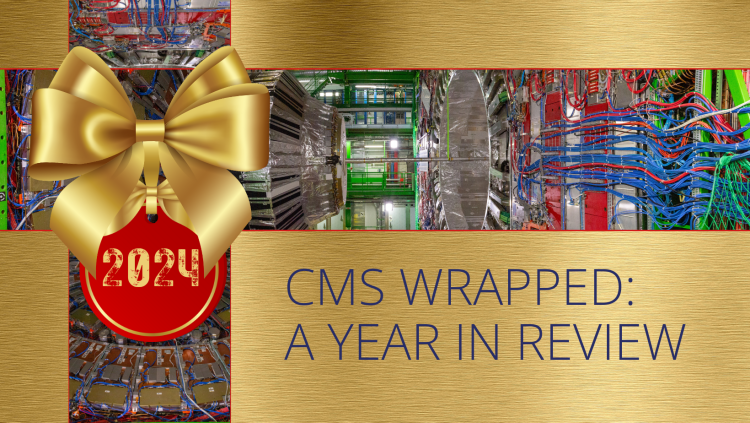
Welcome to our look back at 2024 - and what a year it has been!
After last winter’s planned technical stop of the LHC, everything started back up again so that CMS could continue collecting data for the LHC’s Run 3. We published a piece about how we wake up the CMS detector from these short naps and all the tests we have to go through to make sure it is working in tip-top shape to get the best results possible!
2024 has been the year in which CMS recorded more data than any other year in its history, an incredible win for everybody involved! Alongside this, we had two press releases, one on the most precise measurement of the W boson mass at the LHC, and the other about the entanglement of top quarks!
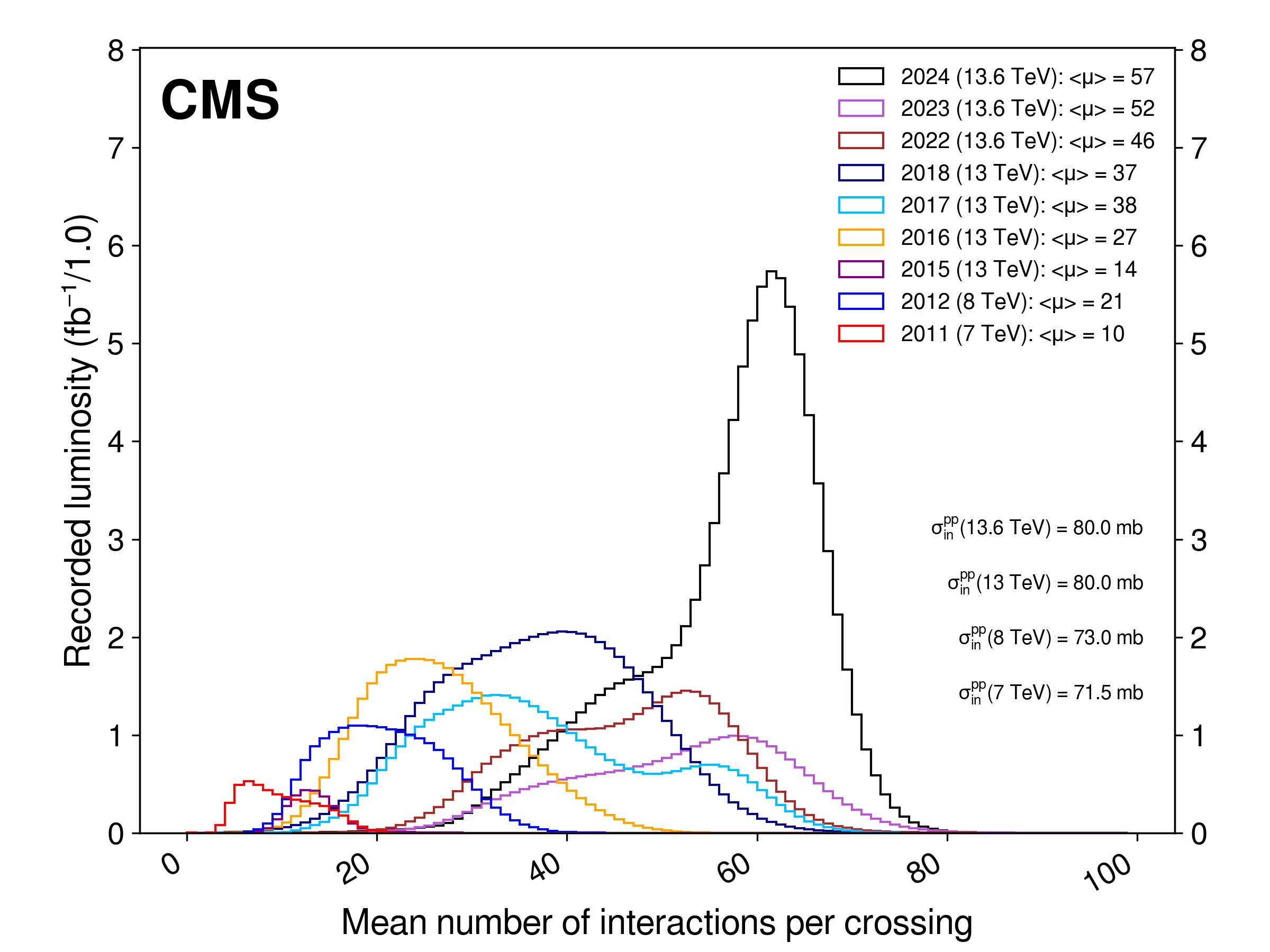
Above: A comparison of the number of interactions per crossing (pileup) distribution for different years of operations, from Run 1 to Run 3.
CMS also saw a change of management in September: the collaboration gave their heartfelt thanks to Patricia McBride, CMS Spokesperson 2022-24, as she steps down at the end of her term, along with deputies Wolfgang Adam and Lucia Silvestris. Gautier Hamel de Monchenault was elected as the new Spokesperson for the term 2024-26, with deputies Anadi Canepa and Hafeez Hoorani - welcome!

Above: TOP: The outgoing Spokesperson Team - Patricia McBride, CMS Spokesperson 2022-24 (middle) with Wolfgang Adam (left) and Lucia Silvestris (right) as Deputy Spokespeople. BOTTOM: The incoming Spokesperson Team - Gautier Hamel de Monchenault, CMS Spokesperson 2024-26 (middle) with Anadi Canepa (left) and Hafeez Hoorani (right) as Deputy Spokespeople. (S.Hurst/CERN)
All the data collected by CMS over the years means more physics analysis and more physics papers and results published. We bring you an explanation of some CMS results in the form of physics briefings - a whopping 57 briefings were released this year and you can find them all here.
Throughout the year, these results and many others were presented by CMSers at a series of conferences such as Moriond, LHCP, ICHEP, Hard Probes, Higgs Hunting, and Top 2024, amongst others.
But there are not just talks at conferences, there are always people with posters of their work! We challenged our young researchers to explain their posters in the one-minute poster challenge - check out their answers here!

Science communications and outreach have also had an increased focus at the conferences, particularly at LHCP and ICHEP, with extended discussions on the learnings and challenges of communications and a whole host of incredible initiatives taking place across the particle physics community.
2024 means CMS celebrates 10 years of Open Data! Over the past decade, CMS has been dedicated to open science, and this commitment continued this year in a big way with the release of over 70 TB of 13 TeV collision data from 2016, and 830 TB of corresponding simulations!
Masterclasses aimed at school-age children and people new to physics research have continued in 2024, based on some of CMS’ open data. This year saw 67 International and 28 Fermilab CMS masterclasses!
CMS celebrated the work of many collaborators throughout the year too! Looking back at 2023, the 2023 CMS awards, Ph.D. thesis awards, and the Industry Gold awards were handed out to the deserving winners who contributed so much to CMS over the year. CMS also teamed up with ATLAS to recognise a decade of innovation by the RD53 collaboration. Recognition for work in 2024 has also started with the Young Researcher Prize, which has just been awarded in the last CMS Week of the year.

The CMS Upgrade Week was a wonderful time to share all the work going on in the labs for the Hi-Lumi CMS - the new form of the CMS detector during the High Luminosity LHC era. In fact, there has been lots of work being done on the detector already to make it ready, such as the first installation of the new forward shielding at the beginning of the year. There is also lots of work continuing across CMS labs worldwide, everything from construction to testing - for example, crystals important for the new detector being tested in Rome - to assembly, before being shipped to CERN sites. Amongst all of this, CMS also needs to make sure data optimisation and flow techniques are ready for the vast increase in data expected

But not everything is about the upgrades! Keeping the experiment running at the excellent level it is at takes a huge amount of people - our CMSers stepped up to populate the control room around the clock in shifts to make this happen. In order to - well - control the detector, CMS built a brand new Control Room that opened this year. On top of maintaining the detector, important improvements have been made in areas such as in the quality of the data collected through the use of AI. Similar steps forward are true across CMS’ operations and these improvements are essential in maintaining CMS, including continuing CMS’ trailblazing commitment to safety. CMS also set new standards for inclusivity with new colour palettes for plots that are much better for people with vision difficulties!
Aside from the engineering and data-taking activities, we saw well over 14,000 visitors step through the gates and experience the uniqueness of CMS! Of that number, there was also one special group from the local community, who we are now working closely with to organise more tours so they, too, can see inside the strange buildings on their doorstep.

Not everybody who visited CMS did so in person - this year we had almost 50 virtual visits so people across the world could enjoy private guided tours by CMS scientists and engineers. We also did a live, special joint visit of both CMS and ATLAS.
This year, for the first time, there is yet another way to experience CMS - in Virtual Reality! All you need is a VR headset and you can access the files here. Could this be a regular offering at your institute?
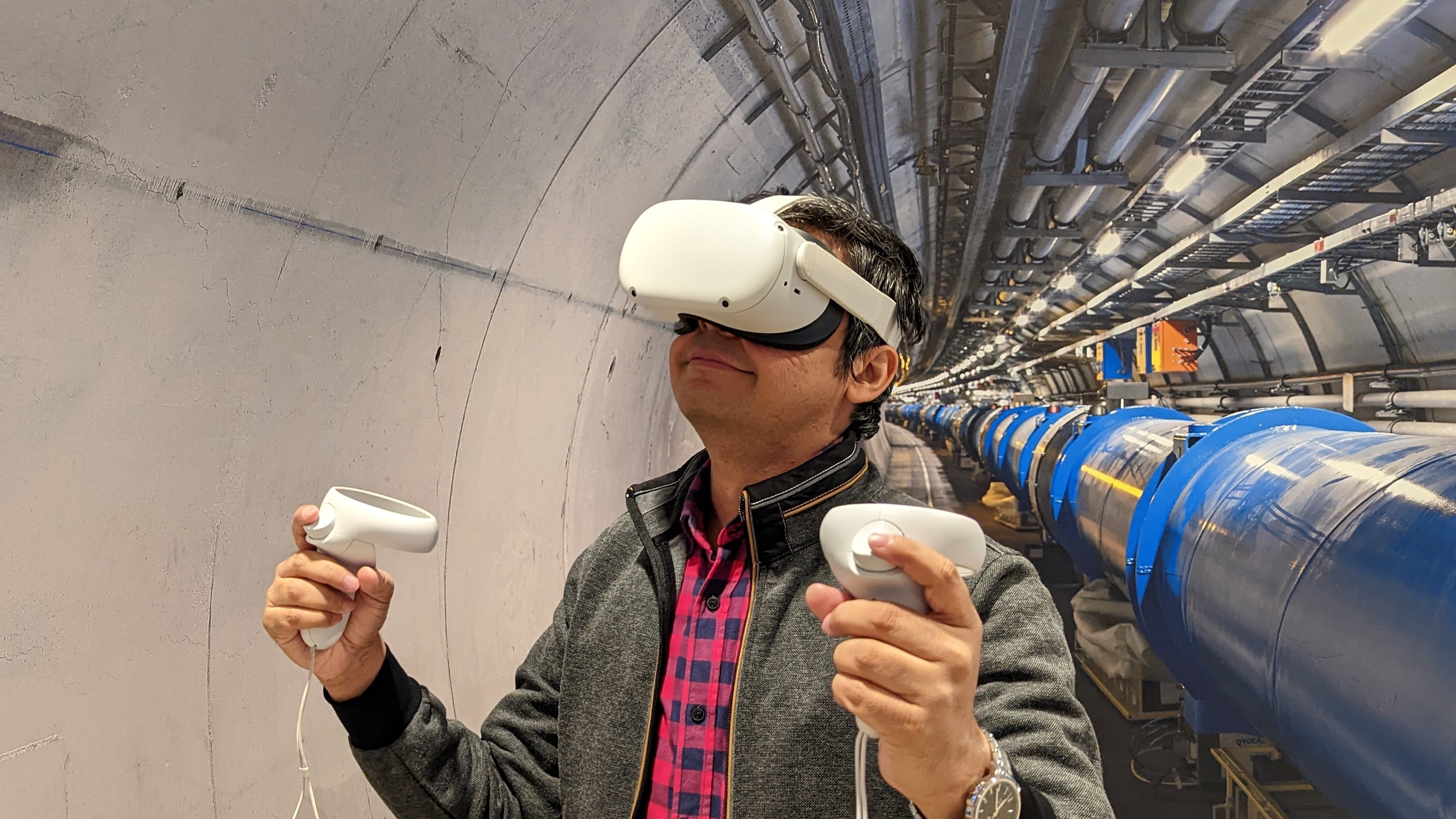
Above: Ansar Iqbal exploring CMS through Virtual Reality
And throughout all of this, our people were involved in a variety of activities including creating video games, exploring new horizons through internships and summer studentships, doing art, performing art, winning prestigious awards, more awards, and achieving their ultimate academic goals.
Let’s dive a bit deeper into some different areas of CMS:
Physics Results
The focal highlight of the year was the culmination of the effort to precisely measure the mass of the W boson. With a precision of 10-4, the result is the most precise at the LHC, and places the value of the W mass in strong agreement with the Standard Model of particle physics [SMP-23-002 Briefing]. Another highlight is the observation of entanglement in top quark-antiquark pairs [TOP-23-001 Briefing][TOP-23-007 Briefing]. In September, CMS released a limit on pseudo-scalar and scalar Higgs bosons decaying into pairs of top quarks. In terms of studying the Higgs boson, not only did CMS “rediscover” the Higgs boson at 13.6 TeV [HIG-23-014 Briefing][HIG-24-013 Briefing], comprehensive sets of Run 2 measurements were combined to investigate the rates of production of Higgs bosons [HIG-23-013 Briefing] and interaction of Higgs bosons with themselves [HIG-20-011 Briefing]. One search for heavier partners of the Higgs boson utilised computer-vision techniques to search for new particles as collimated bursts of light [EXO-22-022 Briefing].

Maintaining its commitment to open science, CMS publicly released the statistical analysis and combination tool ubiquitously used by its analysers, COMBINE [CAT-23-001 Briefing]. Investigating Standard Model physics, CMS significantly improved the constraints on the anomalous magnetic moment of tau leptons [SMP-23-005 Briefing]. A simultaneous fit to seven sets of CMS measurements investigating the Higgs boson, electroweak vector boson, top quark, and multi-jet production was utilised to set constraints on the operators of the standard model effective field theory. In the realm of flavour physics, CMS probed matter-antimatter asymmetry with artificial intelligence [BPH-23-004 Briefing], and measured a set of quantities describing the angular distribution of the particles produced in the decay of B mesons to K mesons and pairs of muons [BPH-21-002 Briefing]. Some other highlights included searching for heavy neutrinos [EXO-22-019 Briefing], measuring the speed of sound in quark-gluon plasma [HIN-23-003 Briefing], and first observation of D0 meson production in photon-lead-nucleus collisions [HIN-24-003 Briefing].
Technical Coordination (TC) of the CMS experiment
2024 began with the conclusion of Extended Year End Technical Stop (EYETS) 2023/24 and ended with preparations for this year’s EYETS 2024/25, maintaining the rhythm of intense activity for the Technical Coordination (TC) team. Following our principles—“Safety, quality, schedule”—we carried out significant maintenance and upgrade tasks on the CMS detector and infrastructure.
With Long Shutdown 3 approaching in July 2026, TC advanced the readiness of the infrastructure for new detectors needed for the LHC High Luminosity, or ‘Hi-Lumi’ phase. A highlight of the year was the installation of the first CO2 cooling plant in the CMS service cavern (USC55), marking a key milestone in the ongoing cooling system project
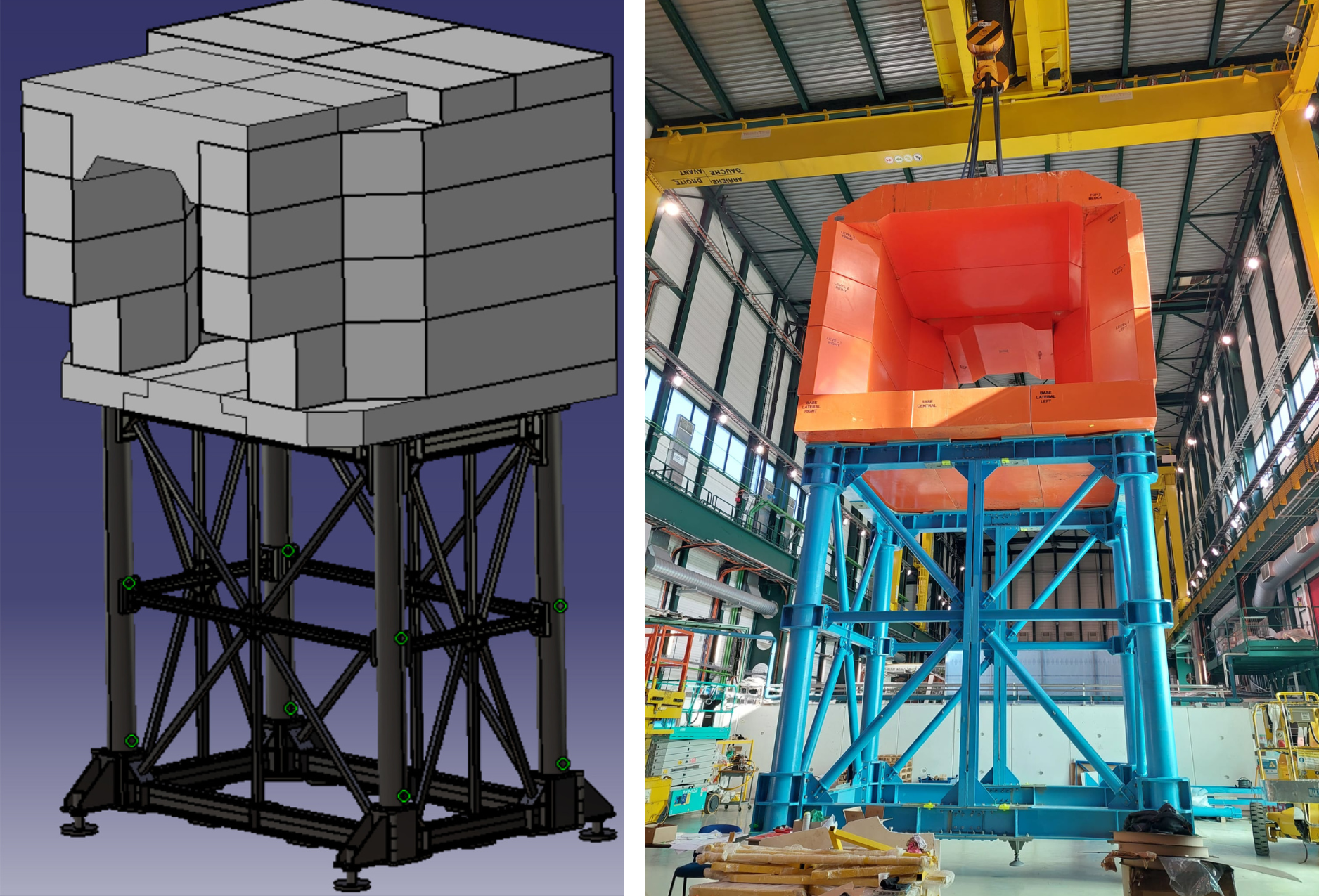
Above LEFT: Conceptual view of the new Forward Shielding assembly – credits to Domenico Dattola (INFN/Torino) and Federico Brunero (CERN). RIGHT: the Shielding assembled above ground before being pulled apart and lowered underground, with credits to Tristan Loiseau.
Tracker
Excellent operational performance was achieved with the current tracker through dedicated efforts from the strips and pixel teams: high-quality data was delivered despite the large amount of integrated luminosity (and radiation) received by the detectors.
The Tracker upgrade project, in preparation for Hi-Lumi, is moving forward: the Inner and Outer Tracker silicon sensors, all chips and the Outer Tracker hybrids are in production and the pre-production of the Inner Tracker and Outer Tracker detector modules and the mechanical support structures has started.
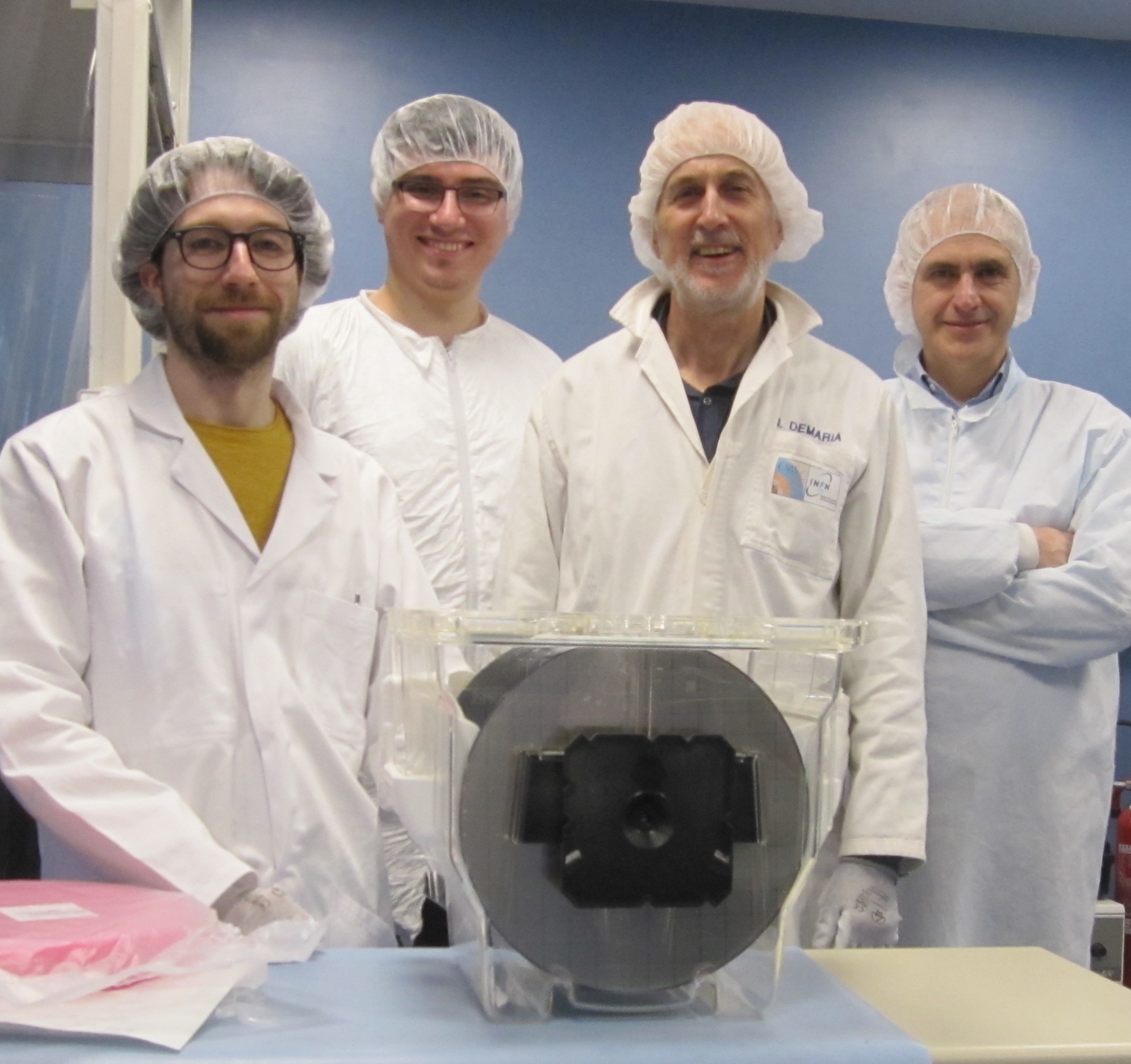
Above: Some of he team during wafer-level testing of the CROCv2 chip engineering run. Fabio Luongo (PhD student, University of Torino), Michael Grippo (PostDoc, INFN), Lino Demaria (INFN researcher), Ernesto Migliore (staff, University of Torino)
MTD - MIP (Minimum Ionising Particles) Timing Detector
The final assembly of the Barrel Timing Layer (BTL), the central part of the new precision MIP timing detector (MTD) for the CMS Phase 2 upgrade, is now in full swing. The common BTL and Tracker Support Tube structure, the BTST, was delivered to CERN in November. This allows the detector integration to start in the integration facility (TIF) at CERN. Delivery, testing and assembly of BTL detector components has been ongoing throughout 2024. The first production quality detector segment, a BTL tray, was finished in summer 2024. Large-scale integration of all 72 trays into the BTST is expected to start in summer 2025.
The Endcap Timing Layer (ETL) has demonstrated the production readiness for their readout ASIC and for their sensors. The sensors, low gain avalanche diodes (LGAD), are a novelty in such a large-scale application and will allow the operation of the ETL in the very hash radiation environment in the most forward region of the CMS detector, close to the beam pipe. System tests on prototypes are ongoing to validate the full detector design and transition to production of all detector components starting in 2025.
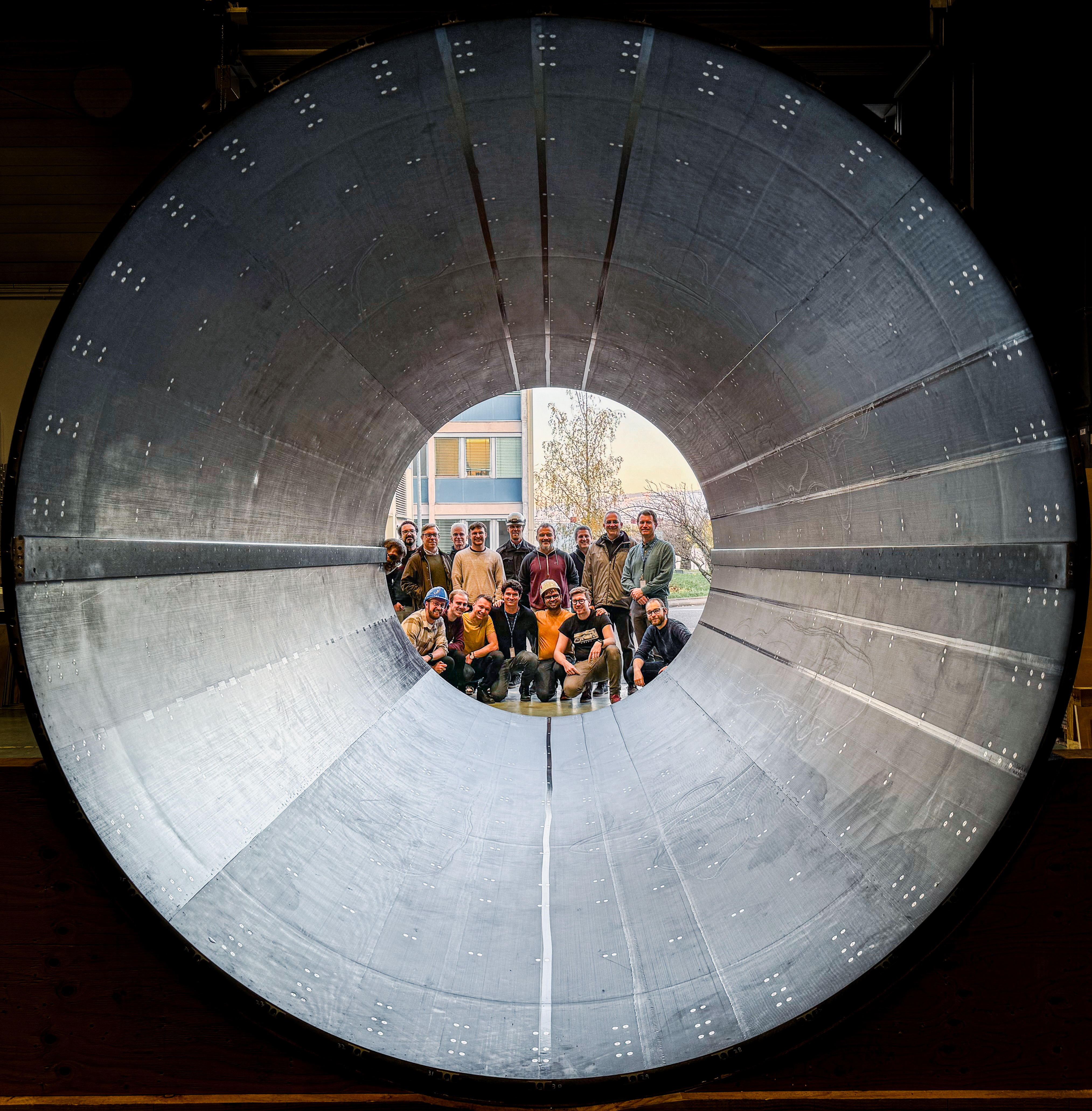
Above: Some of the BTST team after successfully unloading the tube at CERN. (Image: N.A.J. Abdulla)
Muon Systems
In 2024, the CMS Muon Systems demonstrated exceptional progress and operational excellence. The Gas Electron Multiplyer (GEM) system underwent further optimization, resulting in enhanced efficiency and improved timing resolution. The Drift Tube (DT) system sustained its remarkable performance with over 99% active channels and exceptional muon track segment reconstruction efficiency exceeding 99%. Additionally, the DT Slice Test integration using proton-proton collisions validated the entire system chain, providing critical insights to streamline installation and commissioning. The Cathode Strip Chambers (CSC) operated smoothly, maintaining efficiency consistently above 99%. Meanwhile, the Resistive Plate Chambers (RPC) achieved a milestone year with zero downtime, underscoring their reliability.
The Muon Upgrade Projects for the Hi-Lumi LHC are also advancing steadily. A significant milestone was reached with the successful production of the first 80 detectors for the new ME0 station, marking a key step in enhancing the CMS muon system’s coverage and capabilities. The production of new DT on-detector electronics has progressed consistently, while the CSC optical data motherboard production was successfully launched, paving the way for future operations. Furthermore, the production and quality control of the improved RPCs (iRPCs) for the first two disks were completed, reinforcing the system’s reliability and ensuring its readiness for the challenges ahead.

ECAL - Electromagnetic Calorimeter
This year brought significant challenges for ECAL, as it operated under unprecedented pile-up and trigger rates beyond its original design. Although initial operations went smoothly, high dead time emerged in July, temporarily resolved by reducing CMS pile-up. This dead time is largely due to increased noise from ECAL’s aging, and tests are underway to optimize thresholds to minimize future impacts. On the upgrade side, production and testing of electronics for the High-Luminosity LHC are on track. A key achievement was pinpointing the cause of increased power consumption in LiTE-DTU chips, with a new batch now in production. For Hi-Lumi CMS, ECAL is also preparing the integration area at Point 5, the location of the CMS detector and developing procedures for SuperModule refurbishment.

HCAL - Hadron Calorimeter
HCAL operated smoothly throughout 2024 and with automated procedures significantly reduced inefficiency due to data loss. Upgrade of HCAL backend electronics is well on track for Hi-Lumi CMS. Additionally, the HCAL project is making progress on advancing a plan for further improving frontend electronics for high luminosity operations.
HGCAL - High-Granularity Calorimeter, to be included in the Hi-Lumi CMS detector
The last year has been lined up with many milestones for HGCAL. One can mention the completion and furnishing of the Cassette Assembly clean rooms at Fermilab and at Point 5 at CERN, but also a successful beam test for a prototype of the full electronic chain in a close-to-final detector environment. On the mechanical front, the first endcap absorber structure, a key supporting build, has been realised in Pakistan, and hundreds of thousands of production parts have already been produced all around the globe and are being tracked in the database.
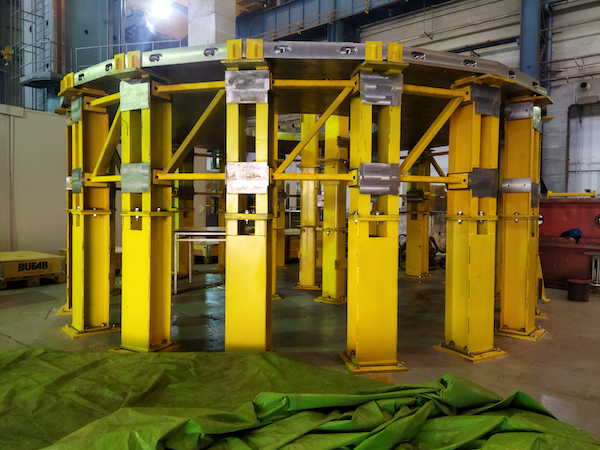
Above: The pre-assembly of the first HGCAL endcap absorber structure has now started in Pakistan.
BRIL - Beam Radiation, Instrumentation, and Luminosity
Throughout the 2024 LHC operation, BRIL provided information to CMS related to the LHC beam conditions: to protect CMS from beam anomalies and to accurately measure the radiation environment and collision luminosity, critical for all physics analyses. In parallel, the BRIL team partially rebuilt several subsystems, soon to be installed in the innermost part of CMS, and worked on the upgrade projects, designing new detectors and associated electronics for Hi-Lumi CMS.
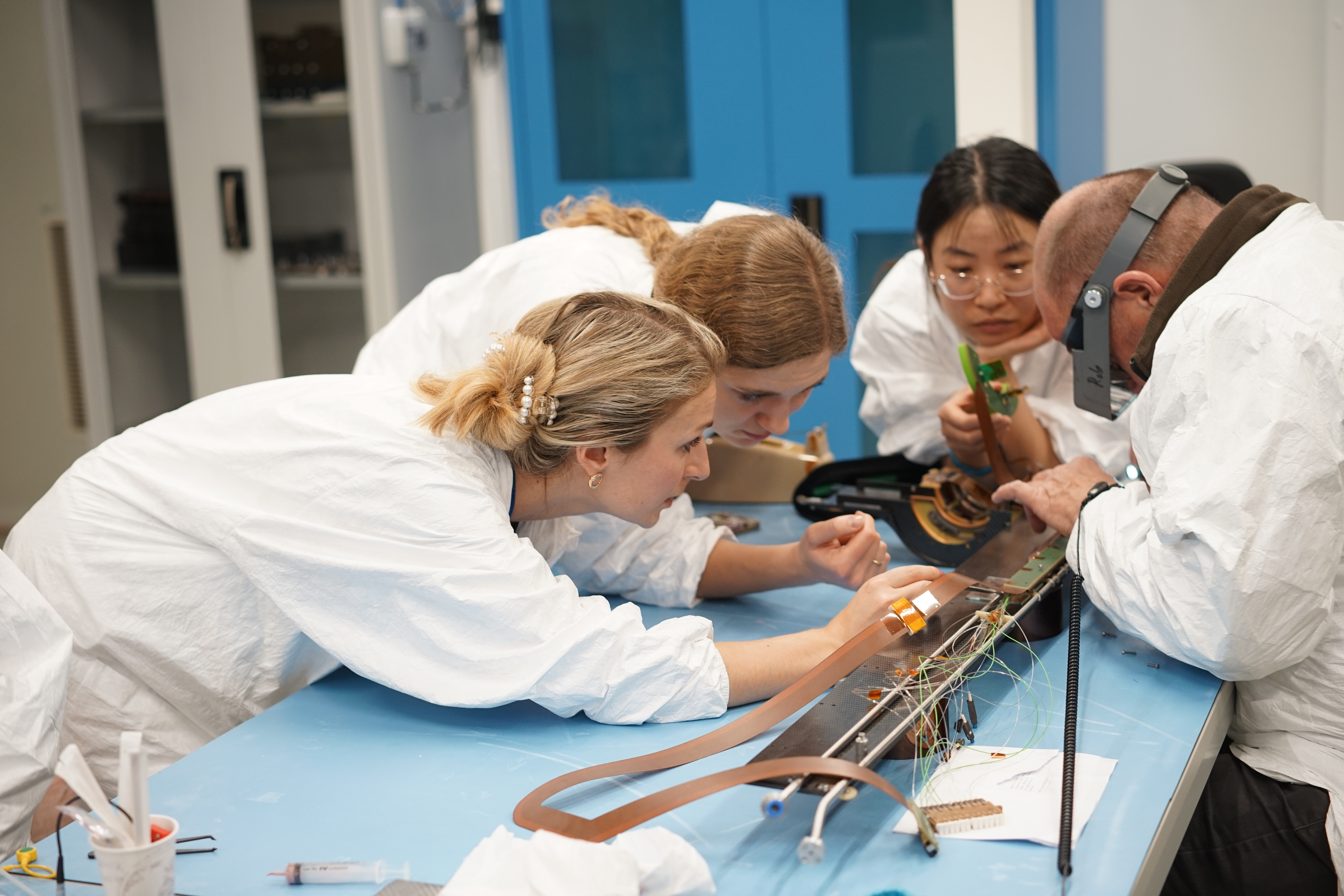
Above: Final steps of the integration process for the BRIL subsystem
PPS - Precision Proton Spectrometer
The PPS team successfully installed all detectors, namely silicon pixel trackers and diamond timing detectors, in both LHC arms at 220 m from the interaction point in IP5 at the beginning of the 2023 data campaign. While the optics of the LHC will change drastically in 2025, all Roman pots will be rotated by 27 degrees to fit the new requirements. Roman pots detect particles scattering from the beam, and are placed as close to the beamline as possible near CMS.
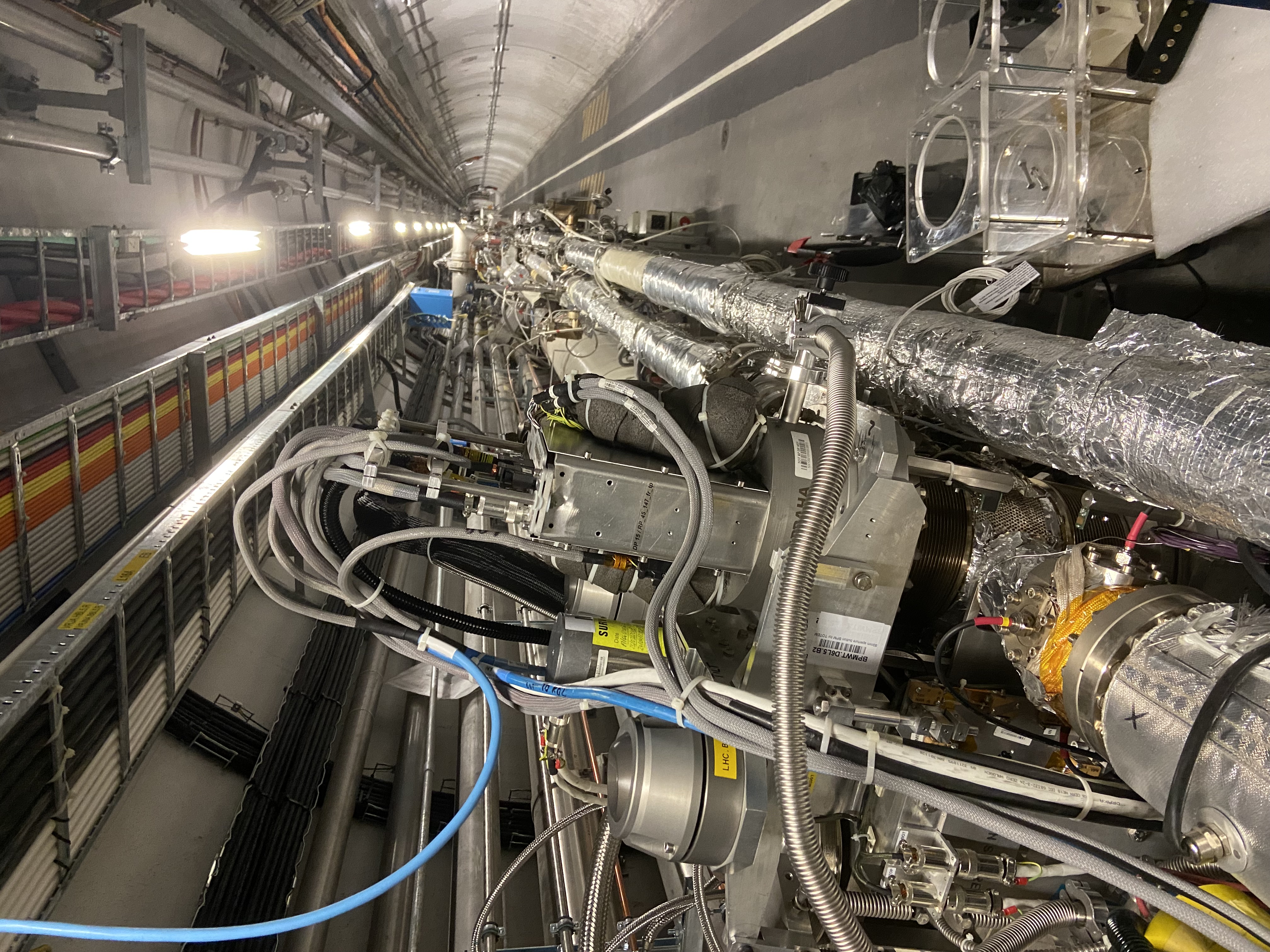
Above: The Roman Pots of PPS seen on the arm between the interaction point towards point 4. (Image: N.Turini)
Level-1 Trigger
The Level-1 Trigger has successfully selected interesting physics events within more than 120 fb-1 of data delivered by the LHC in 2024. Physics selections at the first level of the data acquisition system have introduced totally new and innovative techniques based on machine learning, including unsupervised auto-encoding techniques to search for any anomalies in our data. The trigger system is supported by a 40 MHz scouting system now scanning through our muon and calorimeter data, visualising known physics signals and resonances for the first time. The Hi-Lumi upgrade of the L1 trigger has now entered its production mode and sections of the future hardware are being intensively tested. Further studies of totally new trigger algorithms using modern approaches are investigated with the “Next Generation Trigger” project, which has been successfully launched this year and now growing with young scientists around the globe.
HLT - High Level Trigger
Several improvements were deployed at the High-Level Trigger (HLT) in 2024: the physics reach of the trigger menu was expanded with new triggers and improvements to the online reconstruction, and the software used at HLT to accelerate the online reconstruction using GPUs was updated using the Alpaka portability library, providing a single code base capable of running seamlessly on CPUs as well as different types of GPUs.

DAQ - Data Aquisition
In 2024, the DAQ team extended the High Level Trigger (HLT) farm by 20% and introduced an additional data transfer path to Tier0 before the November Heavy Ion run, increasing the output bandwidth from 20 GB/s to 32 GB/s and enabling the recording of all hard Heavy Ion interactions, including all Minimum Bias events.
In the Hi-Lumi upgrade project, the DAQ team finalised the hardware design of the custom DTH400 and DAQ800 cards. All prototypes are fully functional and hence the series production of over 400 cards has started. All data that CMS takes during the collisions will pass through these cards and hence their reliable functioning is essential for the success of the experiment. These cards are the interface between our custom-designed electronics cards and the commercial high-speed networking equipment.
O&C - Offline and Computing
This year, the computing infrastructure delivered an outstanding performance, allowing for the processing and storage of record-breaking volumes of data. For the first time, CMS Offline & Computing utilized Tier-1 CPU resources to process proton-proton collision data, improving its ability to manage the CMS detector's exceptional output in 2024. Additionally, Offline & Computing coordinated with DAQ, L1 Trigger, and HLT teams to expand the processing of scouting data, which led to the successful deployment of new production workflows.
PPD - Physics Performance and Datasets
The Physics Performance and Datasets coordination area had a very successful year of 2024. For the first time ever, the data delivered by the LHC, collected by CMS and processed in real time is of such a high quality that it can be used “out-of-the-box” for data analysis, without further computing intensive re-processing. It is a great achievement, thanks to the outstanding work of the CMS collaboration in implementing complex real-time calibration mechanisms that are run on-the-fly during data taking. With the help of artificial intelligence, CMS now has the capability of scrutinizing the quality of the data with a thousand times more granularity than otherwise humanly possible. All this, in addition to allowing faster publication of CMS Physics results on more of LHC data, is contributing to the reduction of the costs of science and CMS carbon footprint.

Phew! What a year!
As always, check out our website (you’re on it right now!) and the CMS blogs, and follow us on your social media of choice: Instagram, Bluesky, Facebook, LinkedIn, YouTube, TikTok, and X.
Thank you for joining us on our 2024 journey, and Happy New Year!


